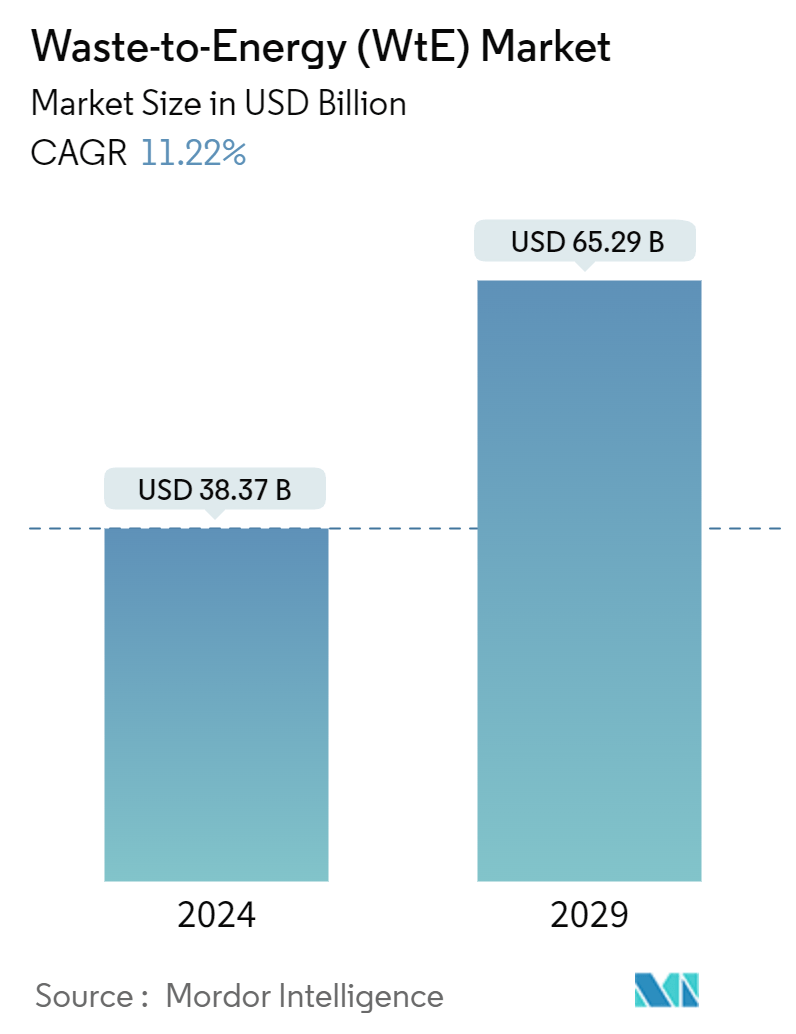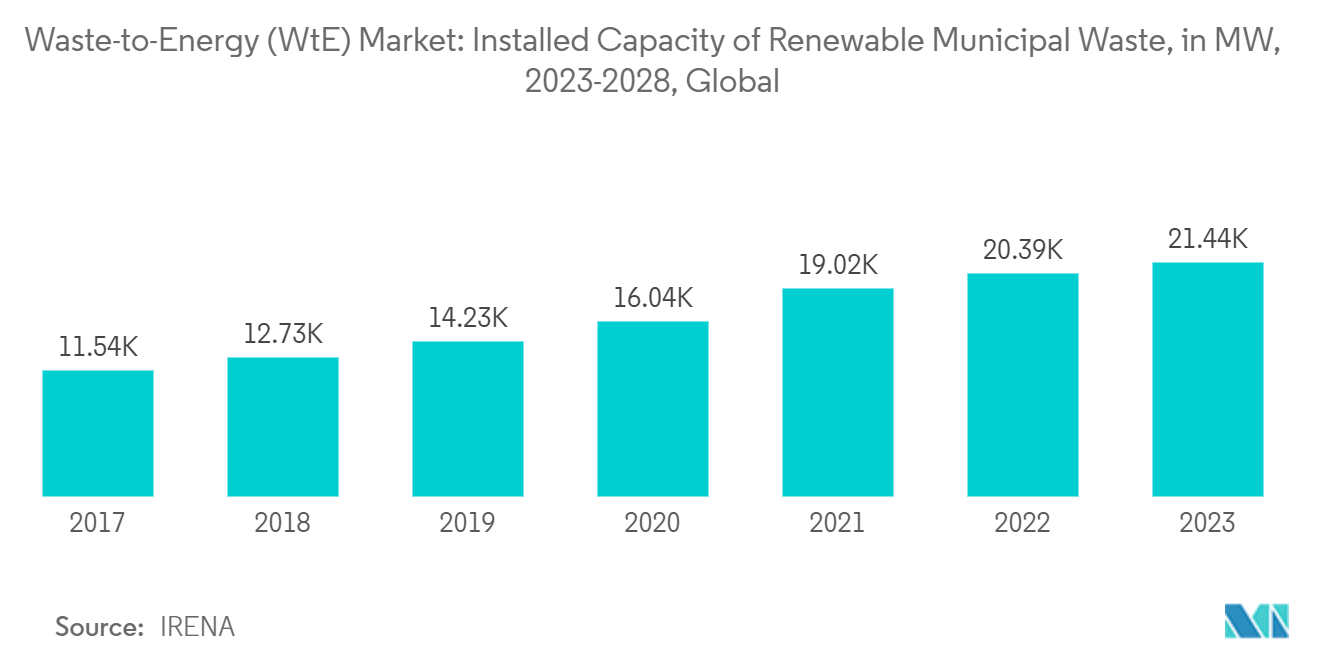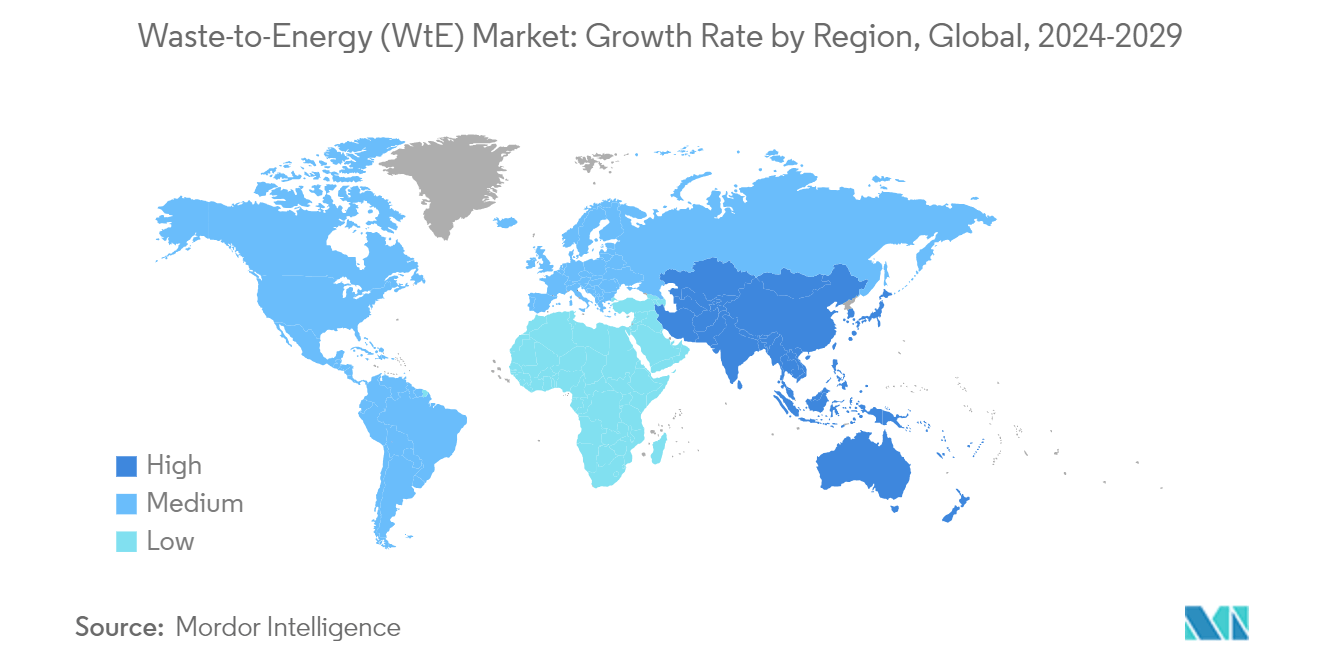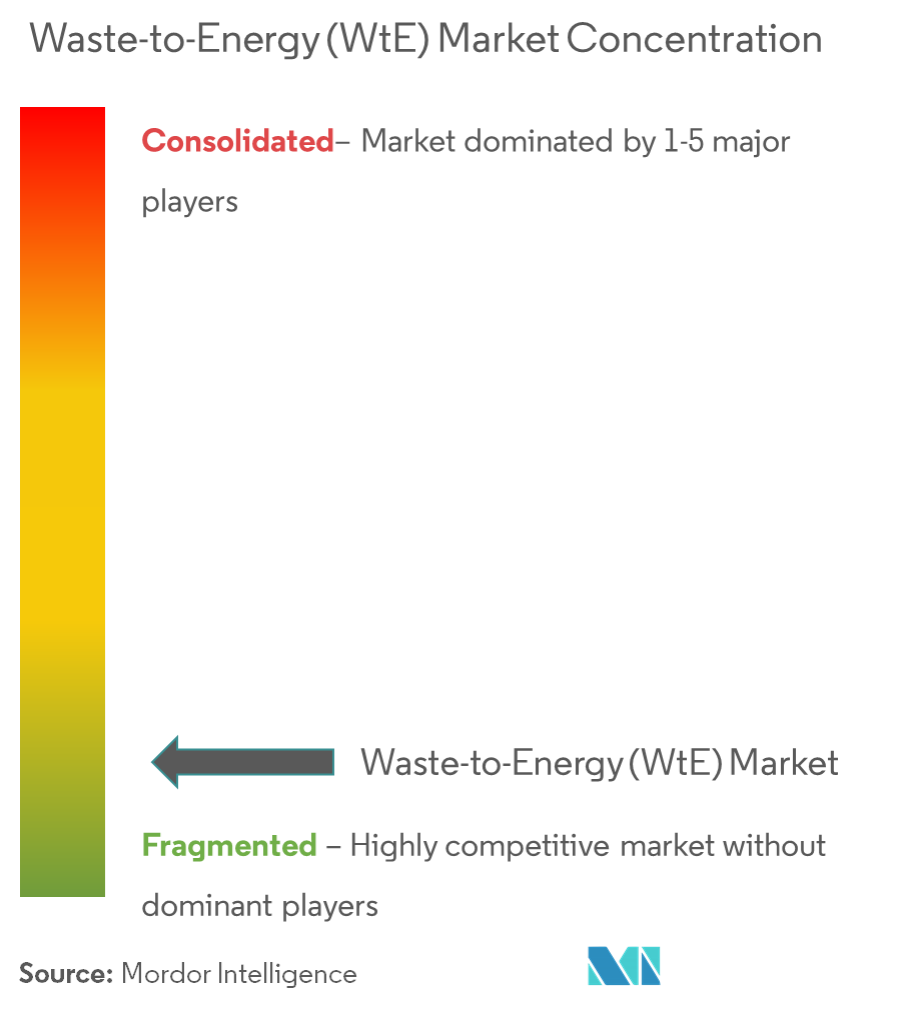Waste to Energy (WTE) Market Size

| Study Period | 2019 - 2029 |
| Market Size (2024) | USD 38.37 Billion |
| Market Size (2029) | USD 65.29 Billion |
| CAGR (2024 - 2029) | 11.22 % |
| Fastest Growing Market | Asia Pacific |
| Largest Market | Asia Pacific |
Major Players*Disclaimer: Major Players sorted in no particular order |
Need a report that reflects how COVID-19 has impacted this market and its growth?
Waste-to-Energy (WtE) Market Analysis
The Waste-to-Energy Market size is estimated at USD 38.37 billion in 2024, and is expected to reach USD 65.29 billion by 2029, growing at a CAGR of 11.22% during the forecast period (2024-2029).
- Over the medium term, factors such as the increasing amount of waste generation, the growing concern for waste management to meet the need for sustainable urban living, and the increasing focus on non-fossil fuel sources of energy are expected to drive the waste-to-energy market.
- On the other hand, the expensive nature of incinerators, declining energy prices decline, and the inability of several plants to cover operating costs are expected to hinder the growth of the market. These factors pose a threat to the waste-to-energy market during the forecast period.
- Nevertheless, emerging waste-to-energy technologies, such as Dendro Liquid Energy (DLE), which is four times more efficient in terms of electricity generation, with additional benefits of no emission discharge and effluence problems at plant sites, are expected to create significant opportunities for the market players, over the coming years.
- Asia-Pacific is expected to dominate the market, with the majority of demand coming from countries such as China, India, and Japan.
Waste-to-Energy (WtE) Market Trends
Thermal-based Waste-to-Energy Segment to Dominate the Market
- Thermal technology is expected to account for the highest market share in the waste-to-energy market during the forecast period, owing to the increasing development of waste incineration facilities worldwide.
- It is estimated that plants that utilize thermal power cogeneration (heating and cooling) and electricity generation can reach optimum efficiencies of 80%. In January 2024, three municipalities of Serbia, Vrnjačka Banja, Trstenik, and Kraljevo, held deliberations with Comef to provide waste-to-thermal-based waste-to-energy solutions. This is likely to help Serbia curb carbon emissions primarily originating from the power generation sector.
- In the present scenario, incineration is the most well-known waste-to-energy technology for municipal solid waste (MSW) processing. However, waste-to-energy technologies, particularly incineration, produce pollution and carry potential health safety risks. To reduce particulate and gas-phase emissions, incineration plant owners have adopted a series of process units for cleaning the flue gas stream, which has, in turn, led to a significant improvement in environmental sustainability.
- Moreover, the heat generated from burning waste is also used as thermal waste for energy generation. In October 2023, the council of Hull District in England gave consent to establish a project worth about USD 33 million that would utilize the energy from building waste. The heat energy obtained would facilitate district heating applications in the city. As per the International Renewable Energy Agency, the installed capacity of renewable municipal waste in 2023 accounted for 21,436 MW, a rise of 5.1% from the previous year.
- Thermal-based waste-to-energy conversion is expected to lead the market, especially in Asia-Pacific's growing economies. The rising urban population is projected to be the key contributing factor to increasing municipal solid waste (MSW).

Asia-Pacific to Dominate the Market
- Asia-Pacific witnessed significant development in the waste-to-energy industry in the past few years. The region dominates the market with increasing efforts taken by the governments to adopt better municipal solid waste (MSW) management practices, providing incentives for waste-to-energy projects in the form of capital subsidies and feed-in tariffs and financial support for R&D projects on a cost-sharing basis.
- Due to economic development and rapid urbanization in India, the generation of municipal solid waste (MSW) has increased rapidly. The Indian government is actively pursuing waste-to-energy projects for electricity generation.
- For instance, in August 2023, the power finance corporation inked a loan agreement with Japan worth about USD 1.28 million to set up an 11 MW waste-to-energy project in Karnataka. The project is likely to consume over 600 tonnes per day of municipal solid waste for electricity generation.
- Japan is one of the leading waste-to-energy markets in Asia-Pacific. The country's waste-to-energy market is driven by efficient solid waste management and financial support for waste-to-energy projects from both national and local governments. The country is expected to introduce waste management and recycling technologies to preserve the environment, effectively turning waste into resources or appropriately disposing of it.
- As per the International Renewable Energy Agency, the total installed capacity of renewable municipal waste in Asia-Pacific hovered around 15063 MW, a rise from 14089 MW from the previous year.
- Therefore, factors such as the increasing amount of waste generated and the efforts taken by various governments to tackle this situation are expected to boost the demand for waste-to-energy plants in Asia-Pacific during the forecast period.

Waste-to-Energy (WtE) Industry Overview
The waste-to-energy (WtE) market is semi-fragmented. Some of the major players operating in this market (in no particular order) include Mitsubishi Heavy Industries Ltd, Waste Management Inc., A2A SpA, Veolia Environnement SA, and Hitachi Zosen Corp., among others.
Waste-to-Energy (WtE) Market Leaders
Mitsubishi Heavy Industries Ltd
Waste Management Inc.
A2A SpA
Veolia Environnement SA
Hitachi Zosen Corp
*Disclaimer: Major Players sorted in no particular order

Waste-to-Energy (WtE) Market News
- April 2023: Egypt signed a USD 120 million contract to design, develop, own, and manage the country's first solid waste-to-electricity facility. The contract was signed by the Giza governorate and a partnership consisting of Renergy Egypt and the National Authority for Military Production. As part of Egypt Vision 2030, the Abou Rawash, Giza plant would convert 1,200 metric tons of household solid waste per day to power.
- January 2023: Lostock Sustainable Energy Plant awarded Babcock & Wilcox a contract to support the delivery of the power train for a waste-to-energy plant near Manchester in the United Kingdom. The plant will create more than 60 MW of energy for people and companies and process around 600,000 metric tons of garbage every year. The contract is valued at USD 65 million.
Waste to Energy (WTE) Market Report - Table of Contents
1. INTRODUCTION
1.1 Scope of the Study
1.2 Market Definition
1.3 Study Assumptions
2. EXECUTIVE SUMMARY
3. RESEARCH METHODOLOGY
4. MARKET OVERVIEW
4.1 Introduction
4.2 Market Size and Demand Forecast, in USD, till 2029
4.3 Municipal Solid Waste (MSW) Generation, in billion metric ton, till 2029
4.4 Government Policies and Regulations
4.5 Recent Trends and Developments
4.6 Market Dynamics
4.6.1 Market Drivers
4.6.1.1 Increasing Amount of Waste Generation, Growing Concern for Waste Management to Meet the Needs for Sustainable Urban Living
4.6.1.2 Increasing Focus on Non-fossil Fuel Sources of Energy
4.6.2 Market Restraints
4.6.2.1 Expensive Nature of Incinerators
4.7 Supply Chain Analysis
4.8 Industry Attractiveness - Porter's Five Forces Analysis
4.8.1 Bargaining Power of Suppliers
4.8.2 Bargaining Power of Consumers
4.8.3 Threat of New Entrants
4.8.4 Threat of Substitutes Products and Services
4.8.5 Intensity of Competitive Rivalry
5. MARKET SEGMENTATION
5.1 By Technology
5.1.1 Physical
5.1.2 Thermal
5.1.3 Biological
5.2 By Geography (Regional Market Analysis {Market Size and Demand Forecast till 2029 (for regions only)})
5.2.1 North America
5.2.1.1 United States
5.2.1.2 Canada
5.2.1.3 Rest of the North America
5.2.2 Asia-Pacific
5.2.2.1 China
5.2.2.2 India
5.2.2.3 Japan
5.2.2.4 Malaysia
5.2.2.5 Thailand
5.2.2.6 Indonesia
5.2.2.7 Vietnam
5.2.2.8 Rest of the Asia-Pacific
5.2.3 Europe
5.2.3.1 Spain
5.2.3.2 Nordic
5.2.3.3 United Kingdom
5.2.3.4 Russia
5.2.3.5 Turkey
5.2.3.6 Germany
5.2.3.7 Italy
5.2.3.8 Rest of the Europe
5.2.4 Middle East and Africa
5.2.4.1 United Arab Emirates
5.2.4.2 Saudi Arabia
5.2.4.3 South Africa
5.2.4.4 Nigeria
5.2.4.5 Qatar
5.2.4.6 Egypt
5.2.4.7 Rest of Middle East and Africa
5.2.5 South America
5.2.5.1 Brazil
5.2.5.2 Argentina
5.2.5.3 Colmbia
5.2.5.4 Rest of South America
6. COMPETITIVE LANDSCAPE
6.1 Mergers and Acquisitions, Joint Ventures, Collaborations, and Agreements
6.2 Strategies Adopted by Leading Players
6.3 Company Profiles
6.3.1 Mitsubishi Heavy Industries Ltd
6.3.2 Waste Management Inc.
6.3.3 A2A SpA
6.3.4 Veolia Environnement SA
6.3.5 Hitachi Zosen Corp
6.3.6 MVV Energie AG
6.3.7 Martin GmbH
6.3.8 Babcock & Wilcox Enterprises Inc.
6.3.9 China Jinjiang Environment Holding Co. Ltd
6.3.10 Suez Group
6.3.11 Xcel Energy Inc.
6.3.12 Wheelabrator Technologies Holdings Inc.
6.3.13 Covanta Holding Corp.
6.3.14 China Everbright Group
- *List Not Exhaustive
6.4 Market Ranking/Share Analysis
7. MARKET OPPORTUNITIES AND FUTURE TRENDS
7.1 Emerging Waste-to-Energy Technologies, such as Dendro Liquid Energy (DLE)
Waste to Energy (WTE) Industry Segmentation
Waste-to-energy plants burn municipal solid waste (MSW), sometimes known as rubbish or trash, to generate steam in a boiler, which is then used to power an electric generator turbine. MSW is a composite of energy-dense items such as paper, plastics, yard trash, and wood products.
The waste-to-energy (WtE) market is segmented by technology and geography. By technology, the market is segmented into physical, thermal, and biological. The report also covers the market size and forecasts for the waste-to-energy (WtE) market across major regions. For each segment, the market sizing and forecasts are provided based on revenue (USD).
| By Technology | |
| Physical | |
| Thermal | |
| Biological |
| By Geography (Regional Market Analysis {Market Size and Demand Forecast till 2029 (for regions only)}) | ||||||||||
| ||||||||||
| ||||||||||
| ||||||||||
| ||||||||||
|
Waste to Energy (WTE) Market Research FAQs
How big is the Waste-to-Energy Market?
The Waste-to-Energy Market size is expected to reach USD 38.37 billion in 2024 and grow at a CAGR of 11.22% to reach USD 65.29 billion by 2029.
What is the current Waste-to-Energy Market size?
In 2024, the Waste-to-Energy Market size is expected to reach USD 38.37 billion.
Who are the key players in Waste-to-Energy Market?
Mitsubishi Heavy Industries Ltd, Waste Management Inc., A2A SpA, Veolia Environnement SA and Hitachi Zosen Corp are the major companies operating in the Waste-to-Energy Market.
Which is the fastest growing region in Waste-to-Energy Market?
Asia Pacific is estimated to grow at the highest CAGR over the forecast period (2024-2029).
Which region has the biggest share in Waste-to-Energy Market?
In 2024, the Asia Pacific accounts for the largest market share in Waste-to-Energy Market.
What years does this Waste-to-Energy Market cover, and what was the market size in 2023?
In 2023, the Waste-to-Energy Market size was estimated at USD 34.06 billion. The report covers the Waste-to-Energy Market historical market size for years: 2019, 2020, 2021, 2022 and 2023. The report also forecasts the Waste-to-Energy Market size for years: 2024, 2025, 2026, 2027, 2028 and 2029.
What are the recent developments in the Waste-to-Energy (WtE) Market?
The recent developments in the Waste-to-Energy (WtE) Market are a) Partnerships between companies to develop new technologies and expand reach b) Focus on integrating waste to energy with circular economy concepts for resource recovery
Waste-to-Energy Plant Industry Report
The global waste-to-energy market is experiencing significant growth, driven by the increasing need for sustainable waste management solutions and energy production. Prominent technologies in this market include thermal and biological methods, with thermal technology, especially incineration, leading due to its efficiency in converting waste to energy. Biological methods like anaerobic digestion are also gaining traction due to technological advancements and environmental viability. The market segments waste into municipal solid waste (MSW), industrial waste, and agricultural waste, with MSW being the largest due to its high volume. Geographically, Europe leads with strict waste management regulations, while Asia Pacific is expected to grow rapidly due to increasing urbanization and industrialization. Despite challenges such as high costs and public opposition due to environmental concerns, the market is supported by stringent environmental regulations, limited landfill availability, and growing energy demands. For a detailed market forecast outlook and historical overview, access a free report PDF download from Mordor Intelligence™ Industry Reports. This analysis provides insights into the waste-to-energy market size, waste-to-energy companies, and the revenue growth rate of the Waste-to-Energy (WtE) sector.
